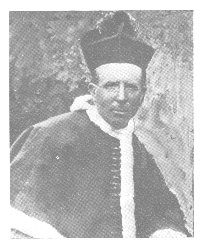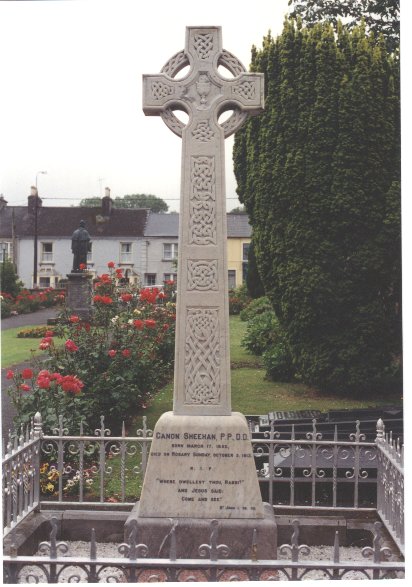

Canon Sheehan


Canon Sheehan's grave and statue in the grounds of the Church of the Nativity of the Blessed Virgin Mary, Doneraile.
Patrick Augustine Sheehan was born in 29, New St. (now O,Brien St.) Mallow, Co. Cork on March 17th. 1852.Even though he was born in Mallow he is invariably referred to as Canon Sheehan of Doneraile, mainly because he wrote almost all of his major works while he was there as Parish Priest. He was one of six children of Patrick Sheehan and Johanna Regan, whose family was widely connected with the Mourne Abbey area.
Patrick received his early education in the Long Room National School in Mallow, where one of his classmates was William O'Brien, later to become a noted journalist and parliamentarian.
When Patrick was growing up in Mallow the Fenian movement was beginning to take shape with men secretly drilling and marching in the woods round about. This period of history remained ingrained in his mind culminating in the book he completed shortly before he died, called The Graves at Kilmorna. It wasn't published until 18 months after his death. He once wrote of the Fenians of his youth as " strong silent men into whose character some stern and terrible energy seemed to have been infused. There were no braggarts among them. Their passion was too deep for words and that passion was all consuming, fierce unswerving love for Ireland".
His carefree youthful days took a severe jolt when in 1863 his father died and in February the following year his mother passed away. Because of this Rev John McCarthy, P.P. of Mallow became guardian of the children with " an income from a modest property ". At the age of 14 he was sent to St. Colmans College in Fermoy. As well as being a secondary school it was also the Diocesan Seminary for the Diocese of Cloyne. When he completed his secondary education in St. Colmans he entered Maynooth, where the records throw little light on the student, whose talents may have been overshadowed by the academic greats of that era in the Seminary. He was a brilliant student who, despite recurring illness, which caused him to miss out a whole years study, still managed to complete his studies in Maynooth a year before he was old enough to be ordained. He was eventually ordained in St. Mary's Cathedral, Cork on Sunday April 18th. 1875 by Bishop Delany.
As there was no vacancy in Cloyne the young priest began his ministry on the Cathedral staff in Plymouth. He returned to Ireland and to Cloyne 1877 and took up duty as a Junior curate in his home town of Mallow. His next move was to Cobh in March 1881, where his experience as a curate in Plymouth stood him in good stead in a town with a large naval presence such as Cobh. Pastoral work always took pride of place with Fr. Sheehan, but it was here that he also began to realise the power of the pen, and used it by contributing to local publications. Ill health again dogged him and he was given the year off to recover his health, which he spent in Youghal where the P.P was on old friend. In 1890 he returned as senior curate to Mallow and this marked a new phase of his literary work, where he considered the use of his pen as a means of spreading the Christian message through short stories, poems and ultimately novels. In 1895 he completed the manuscript of his first novel, Geoffrey Austin Student, and this coincided with his promotion to be Parish Priest of Doneraile.
Doneraile was a large country parish, much different from the parishes he had served in up to then. I quote from " By Pen and Pulpit:-
"Fr. Sheehan began to draw close to the people of Doneraile. His great literacy would lead one to believe he spent the greater part of his life in literary pursuits. This was not so, as writing was always secondary to his sacred duties. Slowly but surely he began to get to grips with this historical parish and as time went by, the people began to see clearly that here was a man who was their friend, and to whom they could turn in times of trouble and distress. They also saw a man who was eager to do what he could for his people, both in a spiritual and temporal way and to improve the Parish as a whole."
His early years in Doneraile coincided with the last stages of the Land War and the introduction of the Land Acts. He played a major part in the negotiations between the tenant farmers and the landlords in the parish. He was the ideal man for this because hi s integrity was never in question and he was respected by all side, even those of different persuasions. He was instrumental in bringing all the negotiations with the landlords to a successful conclusion. The following is an excerpt from a record kept by a J. O'Leary of Carrigeen about the part played by Canon Sheehan in the acquisition of his land.
"...........In 1904 a few of us (tenants) put our heads together and decided to ask Canon Sheehan to come with us to meet our agent (A.G. Creagh of Mallow) in order to put before him our demands to purchase our farms............. I shall never forget that hour, 12 noon of 17th. Sept. 1904 when Canon Sheehan cut the first link of that chain which had bound generations of tenants on the Creagh estate to the chariot of landlordism." He went on to describe the negotiations and the calm dignity of Canon Sheehan in the face of surly and insulting remarks made by the agent's son. On Canon Sheehan's advice the tenants refused to pay rent and after two and a half years the landlord was forced to re-open negotiations and, with a bit of face saving give and take, a deal was concluded and the tenants purchased their farms "at twenty and a half years purchase or 6 shillings and 9d in the pound on the existing rents" All the considerable arrears were wiped out. This agreement was finalised and signed on 14th. July 1907, and the record concludes "The wisdom of his counsel I shall ever treasure and it was ready at all times, any hour night or day. May his saintly spirit ever watch over the parish where his remains lie, is the prayer of J. O'Leary."
Following the satisfactory conclusion of the land purchase, he used his influence in getting as many improvements as possible for Doneraile. he was instrumental in getting an electric plant to provide light for the town and Doneraile Court. The power plant also supplied electricity to pump water to the houses which was an enormous benefit. Lord and Lady Casrletown were very much his supporters in all this.
Lord and Lady Castletown were very friendly with Canon Sheehan and held him in the highest regard. Lady Castletown was formerly Ursula Clare Emily St. Leger of Doneraile Court and Lord Castletown "married in there". Canon Sheehan's success as a writer had turned him into a celebrity, and whenever the Castletowns had a guest of note, they were invariably brought to meet the man of letters. It was through them the Canon met a very famous American for the first time in 1903. He was Justice Oliver Wendall Holmes, the great lawyer, and it was a meeting of two intellectual minds. They became firm friends and engaged in a ten year correspondence which only ended on the Canon's death.
In June 1909 Bishop Doyle of the Diocese of Lismore in New South Wales died and Canon Sheehan was nominated as his replacement. It came as a complete surprise to him but it was out of the question for him to accept owing to the poor state of his health.
His pastoral work in Doneraile cannot be overestimated. He was a great believer in education, and he was a great friend to the Presentation Convent schools and to the Christian Brother's schools in Doneraile. The C.B.S was located in what once had been part of the P.P's garden, Many a poor child who showed academic promise was quietly helped by the Canon.
In 1910 he consulted an eminent surgeon in Dublin, Sir Charles Ball, who diagnosed cancer. He continued to write, during his last illness and his last book The Graves at Kilmorna was published after his death. On November 12 th. 1912 he returned home from hospital and he said to his housekeeper "I am home at last, thank God, and nothing shall ever make me leave it again until I am in my coffin" A short time before he died he was in his study with his brother Denis. He took from his desk a bundle of papers -- they were part of his autobiography. In a feeble voice he said " these might do harm to others, let us destroy them" The papers were then thrown into the fire and reduced to ashes. How valuable to students of the period those papers would be today.
He died on Rosary Sunday Oct. 5th. 1913.
![]()
This was just a short biographical account of Canon Sheehan's life and was taken mostly from By Pen And Pulpit by Michael Barry of Fermoy by whose kind permission I used the information. Any student or indeed anyone interested in the life of Canon Sheehan would do well to read Michael Barry's book as well as Canon Sheehan of Doneraile by M.P. Linehan (1952) and A History of Doneraile by Fr. A. Gaughan.
|
|
Geoffrey Austin, Student. (1895) | |
|
|
The Triumph of Failure. | |
|
|
My New Curate. | |
|
|
Mariae Corona, | |
|
|
Collection of Sermons and Essays. | |
|
|
Luke Delmege. (1901) | |
|
|
Under the Cedars and the Stars. (1902) | |
|
|
Lost Angel of a Ruined Paradise. A Play (1903) | |
|
|
Glenanaar. (1904) | |
|
|
A Spoiled Priest and Other Stories. (1905) | |
|
|
Early Essays and Lectures. (1906) | |
|
|
Lisheen. (1907) | |
|
|
Parerga. (1908) | |
|
|
The Blindness of Dr. Gray. (1909) | |
|
|
The Intellectuals. An Experiment in Irish High Club-Life (1911) | |
|
|
The Queen's Fillet. (1911) | |
|
|
Miriam Lucas. (1912) | |
|
|
The Graves at Kilmorna. (1915) Published after his death. | |
|
|
Cithara Mea. Poems. | |
|
|
A Literary Life. | |
|
|
Tristram Lloyd. (Unfinished and published after his death.) |